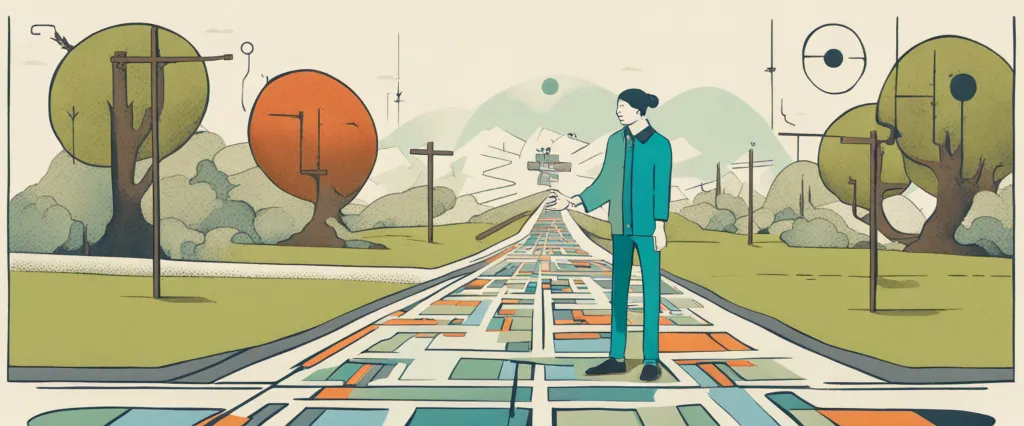
In his groundbreaking book, “A Whole New Mind: Why Right-Brainers Will Rule the Future,” internationally acclaimed author and visionary, Daniel H. Pink, advocates a transformative approach to thrive in an increasingly complex and interconnected world. Pink explores the emerging forces that are reshaping our society and economy, highlighting the vital importance of cultivating right-brain qualities in order to excel in the innovation age. By blending science, psychology, and personal anecdotes, Pink presents a compelling case for embracing a more holistic mindset that combines logic with creativity, empathy, and intrinsic human abilities. Through this summary, we will delve into the key insights and practical strategies outlined by the author, empowering readers to navigate the shifting terrain of the modern world and unlock their full creative potential.
Chapter 1: The Conceptual Age
Chapter 1: The Conceptual Age of the book “A Whole New Mind” by Daniel H. Pink introduces the concept of the new era we are entering, known as the Conceptual Age, and explains why it is necessary for individuals to develop right-brain thinking skills to succeed in this era.
Pink argues that we are transitioning from the Information Age, where logical and analytical thinking skills were highly valued, to the Conceptual Age, where creative and empathetic abilities will be essential. He claims that automation and outsourcing have made routine and repetitive tasks less valuable and accessible, while qualities that cannot be replicated by machines are becoming increasingly valuable, such as creativity, empathy, and the ability to recognize patterns and make connections.
Pink attributes this change to several factors, including abundance, Asia, and automation. Abundance refers to the fact that we now live in a society of surplus where basic necessities are readily available, shifting the focus towards more sophisticated forms of expression and experiences. Asia, with its competitive advantage in routine tasks, has prompted Westerners to seek more innovative and artistic roles. Finally, automation has made it necessary for individuals to possess skills that cannot be easily replicated by machines.
To thrive in the Conceptual Age, Pink argues that individuals need to develop and harness six essential right-brain thinking skills: design, story, symphony, empathy, play, and meaning. These skills, which are rooted in creativity and emotion, will become increasingly important in solving complex problems, contributing to society, and finding opportunities in the changing world.
In summary, Chapter 1 of “A Whole New Mind” sets the stage for the rest of the book by highlighting the shift from left-brain dominance to right-brain thinking skills in the Conceptual Age. It establishes the need for individuals to cultivate creativity, empathy, and other right-brain abilities to succeed in a world where routine tasks are being automated and outsourced.
Chapter 2: The Left Brain and the Right Brain
Chapter 2 of “A Whole New Mind” by Daniel H. Pink explores the popular concept of the left brain and the right brain and delves into how both hemispheres work and interact with each other. Pink explains that the left hemisphere is traditionally associated with logical thinking, analysis, language, and reason, while the right hemisphere is associated with creativity, intuition, emotion, and holistic thinking.
Pink challenges the belief that individuals can be neatly categorized as either left-brained or right-brained. He argues that this oversimplified categorization overlooks the complexity and interconnectedness of the brain. Neurologists recognize that specific functions, such as language or spatial perception, can be more prominent in one hemisphere, but overall, both hemispheres work in tandem.
Furthermore, Pink introduces the concept of “brain plasticity,” which suggests that the brain is malleable and capable of change. He explains how individuals can deliberately develop skills associated with the right hemisphere, such as creativity and empathy, even if they feel more comfortable using their left hemisphere.
To highlight the implications of a rapidly changing world, Pink emphasizes that routine tasks requiring left-brain skills are increasingly being outsourced or automated. In contrast, the demand for right-brain skills, including creativity, empathy, and holistic thinking, is growing in fields such as design, healthcare, and education.
In conclusion, Chapter 2 of “A Whole New Mind” highlights the interdependence and adaptability of both the left and right hemispheres of the brain. It challenges the common left brain versus right brain mentality, encouraging individuals to develop and integrate the skills associated with both hemispheres to thrive in an evolving world.
Chapter 3: The Six Senses
Chapter 3: The Six Senses of the book A Whole New Mind by Daniel H. Pink introduces the concept of six senses that are necessary for individuals to thrive in the new world of work. Pink argues that these senses are essential for success in the Conceptual Age, where creativity and empathy are becoming increasingly valued.
The first sense discussed is Design. Pink emphasizes the importance of aesthetics and the ability to create products and experiences that are not only functional but also visually appealing. He argues that design is no longer just a luxury, but a necessity, as society seeks out products that provide an emotional experience.
Next, Pink explores Storytelling, highlighting its power to captivate, persuade, and engage. The ability to tell compelling stories is seen as a crucial skill for individuals to convey meaning and connect with others on an emotional level.
Empathy is then identified as a vital sense in the Conceptual Age. Pink explains that understanding and relating to others’ emotions is crucial for effective collaboration, negotiation, and problem-solving. Empathy allows individuals to see problems from different perspectives and develop innovative solutions.
Play, the fourth sense, is seen as a key component of creativity and innovation. According to Pink, incorporating playfulness and a sense of humor into work activities can lead to increased productivity and motivation. Play also encourages divergent thinking and helps individuals to overcome obstacles creatively.
Moving on to the fifth sense, Pink introduces the concept of Meaning. He argues that individuals seek a sense of purpose and fulfillment in their work, and that organizations must align their goals with meaningful and socially responsible objectives to attract and retain talent.
Finally, Pink discusses the sense of Symphony, which refers to the ability to synthesize different elements, ideas, and perspectives to create something new and valuable. He suggests that individuals must cultivate their capacity for synthesis to thrive in an era of information overload.
In conclusion, Chapter 3 presents the six senses needed to thrive in the Conceptual Age: Design, Storytelling, Empathy, Play, Meaning, and Symphony. These senses are essential for individuals to navigate the changing landscape of work, where creativity, emotional intelligence, and the ability to integrate various ideas and perspectives are highly valued.
Chapter 4: Design and Storytelling

Chapter 4 of Daniel H. Pink’s book, “A Whole New Mind,” explores the crucial role of design and storytelling in the modern world. Pink argues that in today’s age, where abundance, automation, and the Information Age reign, individuals need to develop a new set of skills to thrive. This involves harnessing the power of design and storytelling to stand out and make meaningful connections.
Design, traditionally associated with aesthetics and functionality, has evolved into something far more essential. Pink suggests that design is now a means of creating empathetic and innovative solutions to problems. It involves identifying and understanding people’s needs and desires and developing products or services that address them effectively. Design thinking has moved beyond simply making things look good and encompasses a deeper understanding of users’ experiences and emotions.
Storytelling, on the other hand, has become a critical skill for individuals to communicate and connect with others effectively. Pink emphasizes the importance of mastering the art of storytelling to capture attention, engage emotions, and convey ideas persuasively. In a world flooded with information, the ability to craft compelling narratives sets individuals apart and enables them to make a greater impact.
Combining design and storytelling, Pink argues, allows individuals to create experiences that resonate deeply with others. By empathizing with people’s desires and conveying ideas through persuasive narratives, individuals can transform their work into something valuable and memorable. This integration of design and storytelling is essential in a world where automation has commoditized many routine tasks, emphasizing the need for human-centered, emotionally engaging experiences.
In conclusion, Chapter 4 highlights the significance of design and storytelling in the modern era. Developing skills in these areas enables individuals to connect with others on a deeper level and create meaningful solutions to complex problems. As the Information Age progresses, these skills become increasingly valuable in cultivating a whole new mind that leads to personal and professional fulfillment.
Chapter 5: Symphony and Synthesis
Chapter 5 of “A Whole New Mind” by Daniel H. Pink, titled “Symphony and Synthesis,” explores the importance of synthesizing information and the ability to see the bigger picture. Pink argues that as society becomes more complex and interconnected, individuals who can connect the dots and recognize patterns will have a competitive advantage.
The chapter begins by discussing the rise of the Information Age, where vast amounts of data are readily available and easily accessible. However, Pink suggests that having access to this information is not enough; individuals need to be able to make sense of it. This is where the ability to synthesize becomes crucial. Synthesizing requires individuals to combine diverse ideas, information, and perspectives to create something new.
Pink presents several examples of individuals who have successfully harnessed this skill, such as inventors, entrepreneurs, and designers who bridge various fields of knowledge to solve complex problems and create innovative products. He also argues that synthesizing is not limited to the realm of creativity but also applies to other professions such as business, medicine, and law.
To develop synthesis skills, Pink suggests engaging in activities that involve pattern recognition, interdisciplinary thinking, and connecting seemingly unrelated ideas. He introduces the concept of “symphony,” which is the ability to see the whole and put the pieces together. Symphony requires a holistic approach and a deep understanding of various disciplines and perspectives.
Overall, Chapter 5 emphasizes the importance of synthesizing information and highlights its value in navigating an increasingly interconnected world. By developing synthesis skills, individuals can become valuable contributors and problem solvers who can see connections that others might overlook.
Chapter 6: Empathy and Relationships
Chapter 6 of “A Whole New Mind” by Daniel H. Pink, titled “Empathy and Relationships,” explores the importance of empathy in various domains of life and work. Pink argues that as society becomes more automated and technology-dependent, human abilities such as empathy are increasingly valuable.
The chapter begins by highlighting the significance of empathy in business and sales. The old model of the salesperson as a pushy persuader is becoming outdated. Instead, successful salespeople now focus on building relationships, understanding their customers’ needs, and providing tailored solutions. Empathy enables them to connect with customers on a deeper level, fostering trust and loyalty.
Pink then delves into the realm of healthcare, illustrating how empathy plays a crucial role in patient care. Empathetic doctors and nurses are more likely to accurately diagnose conditions, provide appropriate treatment, and offer emotional support. The chapter emphasizes that empathy is not just a “soft skill” but has tangible benefits for both patients and healthcare providers.
Furthermore, Pink explores the significance of empathy in education. He argues that teachers who understand their students’ perspectives, motivations, and emotions are more effective in nurturing a love of learning and meaningful engagement. Empathy allows educators to tailor their teaching approaches to address the individual needs of students, fostering deeper connections and enhancing the learning experience.
Finally, the chapter concludes by highlighting the impact of empathy in the workplace, such as improved teamwork, collaboration, and conflict resolution. Employers are increasingly seeking individuals with strong interpersonal skills, as empathy enables employees to understand and relate to their colleagues, clients, and superiors effectively.
In summary, Chapter 6 of “A Whole New Mind” discusses how empathy is becoming increasingly essential in various domains, including business, healthcare, education, and the workplace. It argues that cultivating empathy is not just advantageous but imperative in a world that values human connection and emotional intelligence alongside technical expertise.
Chapter 7: Play and Meaning
Chapter 7 of “A Whole New Mind” by Daniel H. Pink explores the concept of play and its significance in fostering creativity and meaning in our lives. Pink argues that play is not just reserved for children; it is an essential aspect of human experience that adults often neglect.
The chapter begins by highlighting the shift in our culture towards valuing play and its importance in developing skills necessary for the new era of work. Pink suggests that play allows individuals to engage in exploration, experimentation, and collaboration, leading to the discovery of undiscovered talents and the cultivation of innovative ideas.
According to Pink, play is not just a frivolous activity but can be a powerful tool for personal growth and self-discovery. He discusses the concept of “flow,” a state of complete immersion in an activity, where time seems to stop and people experience a sense of deep fulfillment and purpose. Pink encourages readers to seek out activities they are passionate about, which can lead to moments of flow and enhance their overall sense of satisfaction in life.
Furthermore, Pink emphasizes the importance of incorporating playfulness into our professional lives. He argues that play can lead to meaningful and successful work, as it encourages creativity, adaptability, and problem-solving skills. By infusing play into our day-to-day tasks, we are more likely to find fulfillment in our careers and make valuable contributions to society.
In conclusion, Chapter 7 of “A Whole New Mind” emphasizes the significance of play as a means to foster creativity, personal growth, and meaning in our lives. Pink encourages readers to embrace playfulness in both their personal and professional pursuits, allowing them to tap into their full potential and find greater satisfaction in their endeavours.

Chapter 8: The New Mindset for Success
Chapter 8: The New Mindset for Success, of the book A Whole New Mind by Daniel H. Pink, discusses the importance of adopting a new mindset for success in our rapidly changing world. Pink argues that the old mindset, based on logic and analysis, is no longer sufficient for thriving in the twenty-first century.
According to Pink, the new mindset for success is characterized by six essential aptitudes. The first is design, which involves moving beyond function to incorporate beauty and meaning in our products and experiences. Pink emphasizes the significance of aesthetics and empathy, stating that design is no longer a luxury but a necessity for success.
The second aptitude is story, recognizing the power of narrative in conveying ideas and persuading others. Pink emphasizes the value of storytelling skills in communication, as stories engage emotions and help people make sense of overwhelming information.
Next, Pink discusses the importance of play. He argues that playfulness, humor, and laughter bring enjoyment and creativity to our lives, making us better equipped to face challenges and find innovative solutions.
The fourth aptitude is empathy, which involves understanding and connecting with others on an emotional level. Pink highlights the significance of empathy in our increasingly interconnected world, as it enables us to navigate diverse cultures and viewpoints while also fostering collaboration and cooperation.
Moving on, Pink introduces the aptitude of “meaning.” He suggests that finding purpose and making a difference in the world is critical for motivation and fulfillment. This involves aligning our work with our values and creating a positive impact on society.
Finally, Pink explores the aptitude of “the big picture.” This refers to the capacity to think holistically and integrate disparate pieces into a broader context. It involves synthesizing information from various sources to create new insights and uncover hidden patterns.
In conclusion, Chapter 8 of A Whole New Mind emphasizes the necessity of embracing the new mindset for success, characterized by design, story, play, empathy, meaning, and the big picture. These aptitudes are crucial for thriving in our complex and creative age, enabling individuals to adapt and excel in an ever-changing societal landscape.
After Reading
In conclusion, A Whole New Mind by Daniel H. Pink explores the transformative power of right-brain thinking in today’s world. The book argues that as society advances, the demand for left-brain skills such as logic and analysis is diminishing, while the need for creative and empathetic thinking is increasing. Pink identifies six crucial aptitudes – design, story, symphony, empathy, play, and meaning – that individuals can develop to thrive in this new era. He provides practical insights and exercises to cultivate these aptitudes and illustrates with engaging examples of how individuals and businesses have successfully embraced the right-brain thinking mindset. Overall, A Whole New Mind is a thought-provoking guide for individuals seeking to adapt and excel in the evolving landscape of the 21st century.
1. Sapiens: A Brief History of Humankind” by Yuval Noah Harari – This book offers a fascinating perspective on the history of Homo sapiens, exploring how our species evolved and revolutionized the world. It delves into topics like biology, anthropology, and sociology, making it a compelling read for anyone curious about humanity’s past.
2. The Alchemist” by Paulo Coelho – This enchanting novel follows a young Andalusian shepherd named Santiago on his journey to discover the true meaning of life. Filled with mystical elements and profound wisdom, it is a timeless tale that encourages readers to follow their dreams and embrace their destiny.
3. The Power of Now” by Eckhart Tolle – Tolle’s spiritual guidebook explores the concept of mindfulness and living in the present moment. It urges readers to let go of negative thoughts and anxieties, offering practical advice on achieving inner peace and a more fulfilling existence.
4. Norwegian Wood” by Haruki Murakami – Set in 1960s Tokyo, this coming-of-age novel follows Toru Watanabe as he navigates love, friendship, and loss. Murakami’s beautiful prose and introspective storytelling create a compelling narrative that touches on themes of identity, loneliness, and the timeless power of love.
5. The Immortal Life of Henrietta Lacks” by Rebecca Skloot – This thought-provoking non-fiction work tells the story of the woman behind the immortal HeLa cell line, which has revolutionized medical research. Skloot skillfully explores ethical questions surrounding consent, race, and modern biomedical science, making it a captivating and important read for those interested in medical history.



